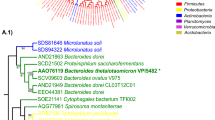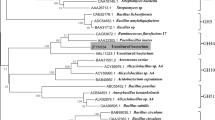Abstract
Western Ghats of India is recognized as one of the 12 mega diversity regions of the world and is the hot spot for unrevealed microbial diversity. To explore the diversity of polysaccharide degrading enzymes in that region, metagenomic library was constructed from forest soil of Southern Western Ghats region. Nine pectinolytic clones with the ability to degrade citrus pectin were isolated based on function based screening of the library. Sequence analysis of pg_4 clone containing revealed that it contained GH family 28 domain (pfam00295) belonging to polygalacturonase superfamily (PLN03003). Its amino acid sequence analysis showed 25–55 % identity to the other well-characterized polygalacturonases. Molecular modeling of pg_4 revealed that it comprised of three right handed-parallel β sheets, one anti-parallel β sheet and one α helix with three conserved catalytic residue D 2263, D 284-85 and H 312 at the C terminal end. The enzyme characterized was able to hydrolyze both apple and citrus pectin with K m values of 1.685 and 1.542 mg ml−1 and retained more that 80 % of activity at pH 5–9 and temperature 20–60 °C.









Similar content being viewed by others
References
Cantarel BL, Coutinho PM, Rancurel C, Bernard T, Lombard V, Henrissat B (2009) The Carbohydrate-Active EnZymes database (CAZy): an expert resource for glycogenomics. Nucleic Acids Res 37:D233–D238
Himmel ME, Bayer EA (2009) Lignocellulose conversion to biofuels: current challenges, global perspectives. Curr Opin Biotechnol 20:316–317
Correia MAS, Mazumder K, Bras JLA, Firbank SJ, Zhu Y, Lewis RJ, York WS, Fontes CMGA, Gilbert HJ (2011) The structure and function of arabinoxylan-specific xylanase. J Biol Chem 286:22510–22520
Aldington S, Fry SC (1993) Oligosaccharins. Adv Bot Res 19:1–101
Shobha MS, Kumar VAB, Tharanathan RN, Rathna K, Anil Kumar AG (2005) Modification of guar galactomannan with the aid of Aspergillus niger pectinase. Carbohydr Polym 62:267–273
Hélène B, Cédric D, Philippe M (2006) Production of oligosaccharides as promising new food additive generation. Food Technol Biotechnol 44:323–333
Kumara HN, Kumar MA, Sharma AK, Sushma HS, Singh M, Singh M (2004) Diversity and management of wild mammals in tea gardens in the rainforest regions of the Western Ghats, India: a case study from a tea estate in the Anaimalai Hills. Curr Sci 87:1282–1287
FAO (2001) Global forest resources assessment 2000—main report. Forestry paper 140
Shivaraj B, Barve N, Kiran MC, Shankar RU, Ganeshaiah KN (2000) Mapping of forests based on biological diversity to identify conservation sites: a case study from Udupi and South Canara districts of Karnataka. J Inst Sci 80:531–536
Kathuria S, Ganeshaiah KN (2002) Tectonic activities shape the spatial patchiness in the distribution of global biological diversity. Curr Sci 82:76–81
Khan M, Kottur J (2012) Expression and purification of organic solvent stable lipase from soil metagenomic library. World J Microbiol Biotechnol 28:2417–2424
Larkin MA, Blackshields G, Brown NP, Chenna R, McGettigan PA, McWilliam H, Valentin F, Wallace IM, Wilm A, Lopez R, Thompson JD, Gibson TJ, Higgins DG (2007) ClustalW and ClustalX version 2. Bioinformatics 23:2947–2948
Gouet P, Courcelle E, Stuart DI, Metoz F (1999) ESPript: multiple sequence alignments in PostScript. Bioinformatics 15:305–308
Ombet C, Jambon M, Deléage G, Geourjon GC (2002) Geno3D: automatic comparative molecular modelling of protein. Bioinformatics 18:213–214
Pickersgill R, Smith D, Worboys K, Jenkins J (1998) Crystal structure of polygalacturonase from Erwinia carotovora sp. carotovora. J Biol Chem 273:24660–24664
Huang CC, Couch GS, Pettersen EF, Ferrin TE (1996) Chimera: an extensible molecular modeling application constructed using standard components. Pac Symp Biocomput 1:724
Laskowski RA, MacArthur MWD, Moss S, Thornton JM (1993) PROCHECK: a program to check the stereochemical quality of protein structures. J Appl Crystallogr 26:283–291
Eisenberg D, Lüthy R, Bowie JU (1997) VERIFY3D: assessment of protein models with three-dimensional profiles. Methods Enzymol 277:396–404
Benkert P, Künzli M, Schwede T (2009) QMEAN server for protein model quality estimation. Nucleic Acids Res 1;37(Web server issue):W510–W514
Colovos C, Yeates TO (1993) Verification of protein structures: patterns of nonbonded atomic interactions. Protein Sci 2(9):1511–1519
Wiederstein M, Sippl MJ (2007) ProSA-web: interactive web service for the recognition of errors in three-dimensional structures of proteins. Nucleic Acids Res 35:W407–W410
Gelly JC, Joseph AP, Srinivasan N, de Brevern AG (2011) iPBA: a tool for protein structure comparison using sequence alignment strategies. Nucleic Acids Res 39:W18–W23
Dundas J, Ouyang Z, Tseng J, Binkowski A, Turpaz Y, Liang J (2006) CASTp: computed atlas of surface topography of proteins with structural and topographical mapping of functionally annotated residues. Nucleic Acids Res 34:W116–W118
Miller GL (1959) Use of dinitrosalicylic acid reagent for determination of reducing sugars. Anal Chem 31:426–428
Dereeper A, Guignon V, Blanc G, Audic S, Buffet S, Chevenet F, Dufayard JF, Guindon S, Lefort V, Lescot M, Claverie JM, Gascuel O (2008) Phylogeny.fr: robust phylogenetic analysis for the non-specialist. Nucleic Acids Res 36:W465–W469
Pijning T, van Pouderoyen G, Kluskens L, van der Oost J, Dijkstra BW (2009) The crystal structure of a hyperthermoactive exopolygalacturonase from Thermotoga maritima reveals a unique tetramer. FEBS Lett 583:3665–3670
Markovic O, Janecek S (2001) Pectin degrading glycoside hydrolases of family 28 sequence-structural features, specificities and evolution. Protein Eng 14:615–631
Palanevelu P (2006) Polygalacturonase: active site analysis and mechanism of action. Indian J Biotechnol 5:148–162
Van Santen Y, Benen JAE, Schroter KH, Kalk KH, Armand S, Visser J, Dijkstra BW (1999) 1.68 Å crystal structure of endopolygalacturonase II from Aspergillus niger and identification of active site residues by site-directed mutagenesis. J Biol Chem 274:30474–30480
Matsumura M, Signor G, Matthews BW (1989) Substantial increase of protein stability by multiple disulphide bonds. Nature 342:291–293
de Botella CI, Ory CW, Cantero D, Blandino A (2005) Hydrolytic enzyme production by Aspergillus awamori on grape pomace. Biochem Eng J 26:100–106
Li ZM, Bai ZH, Zhang BG, Xie HJ, Hu QB, Hao CB, Xue WT, Zhang HX (2005) Newly isolated Bacillus gibsonii S-2 capable of using sugar beet pulp for alkaline pectinase production. World J Microbiol Biotechnol 21:1483–1486
Kluskens LD, van Alebeek GJWM, Walther J, Voragen AGJ, de Vos WM, van der Oost J (2005) Characterization and mode of action of an exopolygalacturonase from the hyperthermophilic bacterium Thermotoga maritima. FEBS J 272:5464–5473
Niture SK, Pant A, Kumar AR (2001) Active site characterization of the single endo-polygalacturonase produced by Fusarium moniliforme NCIM 1276. Eur J Biochem 268:832–840
Martins ES, Silva D, Leite RS, Gomes E (2007) Purification and characterization of polygalacturonase produced by thermophilic Thermoascus aurantiacus CBMAI-756 in submerged fermentation. Antonie Van Leeuwenhoek 91:291–299
Devi NA, AppuRao AG (1996) Fractionation, purification, and preliminary characterization of polygalacturonases produced by Aspergillus carbonarius. Enzyme Microb Technol 18:59–65
Gumadadi SN, Panda T (2003) Analysis of kinetic data of pectinases with substrate inhibition. J Microbiol Biotechnol 13:332–337
Khan M, Nakkeeran E, Umesh-Kumar S (2013) Potential application of pectinase in developing functional foods. Annu Rev Food Sci Technol 4:2.1–2.14
Author information
Authors and Affiliations
Corresponding author
Rights and permissions
About this article
Cite this article
Sathya, T.A., Jacob, A.M. & Khan, M. Cloning and molecular modelling of pectin degrading glycosyl hydrolase of family 28 from soil metagenomic library. Mol Biol Rep 41, 2645–2656 (2014). https://doi.org/10.1007/s11033-014-3123-8
Received:
Accepted:
Published:
Issue Date:
DOI: https://doi.org/10.1007/s11033-014-3123-8




